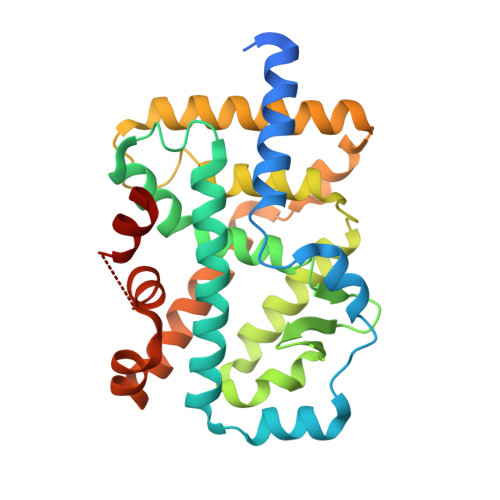Discovery of BMS-986251: A Clinically Viable, Potent, and Selective ROR gamma t Inverse Agonist.
Cherney, R.J., Cornelius, L.A.M., Srivastava, A., Weigelt, C.A., Marcoux, D., Duan, J.J., Shi, Q., Batt, D.G., Liu, Q., Yip, S., Wu, D.R., Ruzanov, M., Sack, J., Khan, J., Wang, J., Yarde, M., Cvijic, M.E., Mathur, A., Li, S., Shuster, D., Khandelwal, P., Borowski, V., Xie, J., Obermeier, M., Fura, A., Stefanski, K., Cornelius, G., Tino, J.A., Macor, J.E., Salter-Cid, L., Denton, R., Zhao, Q., Carter, P.H., Dhar, T.G.M.(2020) ACS Med Chem Lett 11: 1221-1227
- PubMed: 32551004
- DOI: https://doi.org/10.1021/acsmedchemlett.0c00063
- Primary Citation of Related Structures:
6VQF - PubMed Abstract:
Novel tricyclic analogues were designed, synthesized, and evaluated as RORγt inverse agonists. Several of these compounds were potent in an IL-17 human whole blood assay and exhibited excellent oral bioavailability in mouse pharmacokinetic studies. This led to the identification of compound 5 , which displayed dose-dependent inhibition of IL-17F production in a mouse IL-2/IL-23 stimulated pharmacodynamic model. In addition, compound 5 was studied in mouse acanthosis and imiquimod-induced models of skin inflammation, where it demonstrated robust efficacy comparable to a positive control. As a result of this excellent overall profile, compound 5 (BMS-986251) was selected as a clinically viable developmental candidate.
- Bristol Myers Squibb Company, Research and Early Development, Princeton, New Jersey 08540-4000, United States.
Organizational Affiliation:

















